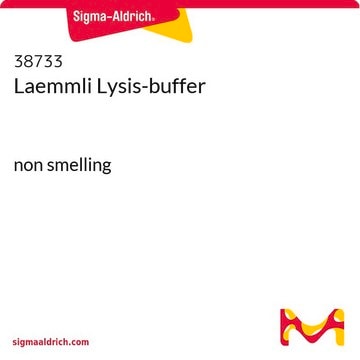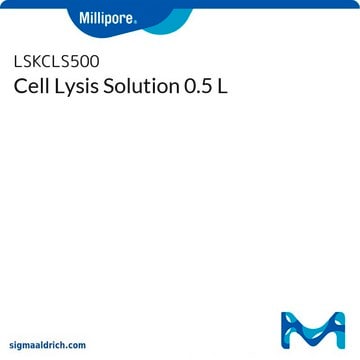20-188
RIPA Lysis Buffer, 10X
100 mL RIPA Lysis Buffer, 10X for Immunoprecipitation & Western Blotting.
Synonym(s):
lysis buffer
Sign Into View Organizational & Contract Pricing
All Photos(1)
About This Item
UNSPSC Code:
41116010
eCl@ss:
42029053
NACRES:
NB.22
Recommended Products
form
liquid
packaging
pkg of 100 mL
manufacturer/tradename
Upstate®
technique(s)
immunoprecipitation (IP): suitable
western blot: suitable
shipped in
ambient
General description
Radioimmunoprecipitation assay (RIPA) Buffer aids in cell lysis and solubilization of proteins from both adherent and suspension-cultured mammalian cells. In addition, this buffer helps in relevant protein-protein interactions studies by reducing non-specific protein-binding interactions to keep background low, while allowing most specific interactions to occur.
Application
RIPA Lysis Buffer, 10X has been used for cell lysis during the sample preparation for immunoprecipitation and western blot.
Physical form
0.5M Tris-HCl, pH 7.4, 1.5M NaCl, 2.5% deoxycholic acid, 10% NP-40, 10mM EDTA.
Storage and Stability
6 months at room temperature
Legal Information
UPSTATE is a registered trademark of Merck KGaA, Darmstadt, Germany
Disclaimer
Unless otherwise stated in our catalog or other company documentation accompanying the product(s), our products are intended for research use only and are not to be used for any other purpose, which includes but is not limited to, unauthorized commercial uses, in vitro diagnostic uses, ex vivo or in vivo therapeutic uses or any type of consumption or application to humans or animals.
Signal Word
Danger
Hazard Statements
Precautionary Statements
Hazard Classifications
Aquatic Chronic 3 - Eye Dam. 1
Storage Class Code
10 - Combustible liquids
WGK
WGK 3
Certificates of Analysis (COA)
Search for Certificates of Analysis (COA) by entering the products Lot/Batch Number. Lot and Batch Numbers can be found on a product’s label following the words ‘Lot’ or ‘Batch’.
Already Own This Product?
Find documentation for the products that you have recently purchased in the Document Library.
Customers Also Viewed
Lena Gamboa et al.
ACS chemical biology, 15(2), 533-542 (2020-01-07)
CRISPR-associated proteins (Cas) are enabling powerful new approaches to control mammalian cell functions, yet the lack of spatially defined, noninvasive modalities limits their use as biological tools. Here, we integrate thermal gene switches with dCas9 complexes to confer remote control
Ya-Hui Chen et al.
Cancer management and research, 12, 4645-4665 (2020-07-02)
Pancreatic ductal adenocarcinoma (PDAC) is a highly aggressive malignancy with an overall 5-year survival rate of 9.3%, and this malignancy is expected to become the second leading cause of cancer-related death by 2030. Gemcitabine resistance develops within weeks of PDAC
Carla Maiara Lopes Cardozo et al.
Molecules (Basel, Switzerland), 25(11) (2020-06-14)
There are still controversies regarding the correlation between the beneficial effects for health and the administration of isolated compounds or crude extracts in therapeutic applications. Campomanesia xanthocarpa, found in the Brazilian Cerrado, demonstrated beneficial effects in metabolic disorders associated with
Suji Han et al.
Cancers, 11(12) (2019-11-28)
Glioblastoma is a highly aggressive and lethal brain tumor, with limited treatment options. Abnormal activation of the neddylation pathway is observed in glioblastoma, and the NEDD8-activating enzyme (NAE) inhibitor, MLN4924, was previously shown to be effective in glioblastoma cell line
Ayodele Akintayo et al.
The Journal of biological chemistry, 295(41), 14053-14064 (2020-08-09)
The membrane-bound, long form of MGAT4D, termed MGAT4D-L, inhibits MGAT1 activity in transfected cells and reduces the generation of complex N-glycans. MGAT1 is the GlcNAc-transferase that initiates complex and hybrid N-glycan synthesis. We show here that Drosophila MGAT1 was also
Our team of scientists has experience in all areas of research including Life Science, Material Science, Chemical Synthesis, Chromatography, Analytical and many others.
Contact Technical Service













